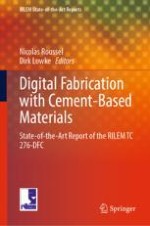2022 | OriginalPaper | Chapter
6. Structural Design and Testing of Digitally Manufactured Concrete Structures
Authors : Domenico Asprone, Costantino Menna, Freek Bos, Jaime Mata-Falcón, Liberato Ferrara, Ferdinando Auricchio, Ezio Cadoni, Vítor M. C. F. Cunha, Laura Esposito, Asko Fromm, Steffen Grünewald, Harald Kloft, Viktor Mechtcherine, Venkatesh Naidu Nerella, Roel Schipper
Published in: Digital Fabrication with Cement-Based Materials
Publisher: Springer International Publishing
Activate our intelligent search to find suitable subject content or patents.
Select sections of text to find matching patents with Artificial Intelligence. powered by
Select sections of text to find additional relevant content using AI-assisted search. powered by
